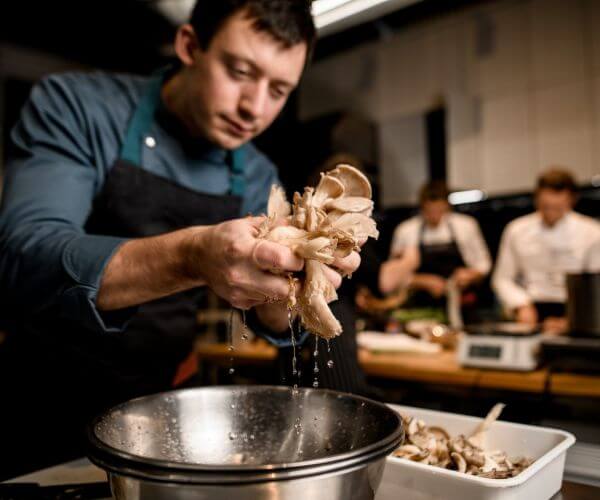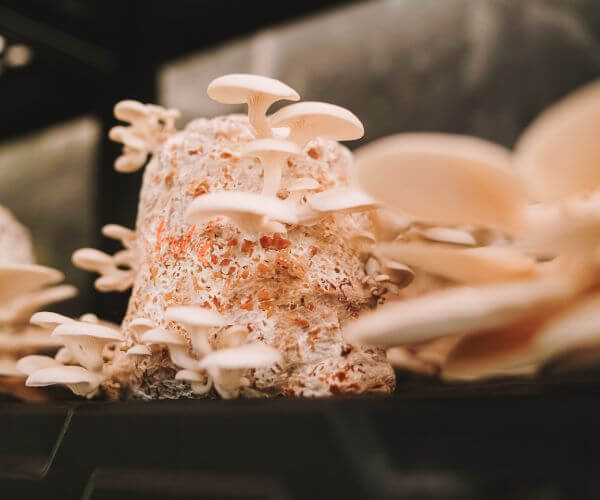You’re stranded on a deserted island and can only bring three mushrooms. Which do you choose?
Admit it, a Psilocybe strain was the first to pop into your head! While that’s an obvious choice, those in the know will also have Oyster mushrooms (Pleurotus sp.) at the top of their list. For this ubiquitous mushroom, the majesty lies in their commonality.
At the Fungi Academy we have a saying: “For every human problem, there’s a fungal solution”. Most of this confidence spawns from the amazing abilities of Oyster mushrooms.
To date, oyster mushrooms have proven to be the most versatile species for human application, filling every requirement for survival on this island of yours.
Want to learn how to grow mushrooms at home? They are one of the easiest and most resilient species you will find.
Want to create food security? Clean water? Remove pollutants from the soil? Check. Check. Check.
No task is too tall for this fungal friend. All hail Pleurotus Ostreatus Maximus, the mushroom gladiator!
Heck, even Uncle Paul agrees:
If one mushroom can steer the world on the path to greater sustainability, fighting hunger, increasing nutrient return pathways in ecosystems, destroying toxic wastes, forestalling disease, and helping communities integrate a complexity of waste streams, Oysters stand out.
Paul Stamets, Mycelium Running
Without further ado, here are 10 Reasons Why Oyster Mushrooms are the Swiss Army Knife of the Fungal Queendom!
1. Omnipresent Oysters
Just like your cousin Felicia, some mushrooms only thrive in one type of climate. But Oyster mushrooms are far from delicate – one might even consider them the global citizen of queendom fungi. They can be found on every continent in the world (save Antarctica) in temperate and subtropical forests.
If you’re interested in growing mushrooms at home, oyster mushrooms prefer incubation temperatures ranging from 21-30°C and fruiting temperatures from 13-30°C but can thrive outside those wide parameters, too.
2. Omnivore Oysters
Oyster mushrooms have voracious appetites and will digest almost anything in their path. As saprophytic fungi, they are the great decomposers of our world, transforming dead organic matter into useful compounds and new life. Like every family, there are some picky eaters in the fungal community, but oysters are mushroom pigs and will always clean the plate!
Not only does this make them great recyclers of otherwise ‘useless’ material, but their ability to grow on things we consider waste like used corn cobs, straw, and coffee grounds also makes cultivation costs extremely low for home cultivators.
3. Myco-Remediation Masters
Mycoremediation is a form of bioremediation where mushrooms are used to remove harmful pollutants from the environment. To this end, oyster mushrooms lead the way, demonstrating an appetite for petroleum, heavy metals, even diesel products! In one study, 95% of the polyaromatic hydrocarbons from contaminated soil was removed by Oyster mycelium using those amazing enzymes that also make it such a great decomposer.
In fact, mycology guru Paul Stamets was one of the first to popularize using oyster mushrooms for such purposes in his book Mycelium Running. Now, Stamets and his team are experimenting with creative ways to export this technology off-land with his MycoBoom prototype. Given oyster mushrooms’ ability to colonize substrate soaked in saltwater, we may even begin to see buoys of oyster spawn soaking up oil spills in the open ocean someday.

4. Myco-Filtration
Did you know you can filter chemicals, dyes, and harmful bacteria like E.Coli from water using an Oyster mushrooms’ mycelial network? These networks are incredibly dense and contain so much surface area that they can trap a multitude of harmful chemicals as water flows through their mycelium.
Oyster mushrooms are particularly efficient at this because of their high biomass compared to other mushrooms. This provides the massive potential to clean up aquifers using myceliated hay bales as buffers to prevent harmful compounds within agricultural runoff and city centres from entering the water table.
5. Nutritious + Delicious!
One of the main reasons Oyster mushrooms are cultivated on such a large scale is that they make a great addition to almost any meal! Seasoned on their own or part of a larger dish (stir-fries and on pizza are our favorite), Oyster mushrooms are a great source of vitamins D, niacin, and B5, which helps strengthen bones, reduce cholesterol, and transform fats into usable energy. They also provide a sustainable source of protein for those practicing a vegan diet!
6. Eat Your Medicine
Oyster mushrooms might not be the first to pop into your mind when you hear “medicinal mushrooms” but they are packed full of compounds that can help reduce cholesterol, inflammation, and even slow the growth of cancer cells. They are also a great source of antioxidants that assist your body in the fight against free radicals. Rad, broyster!

7. Eco-friendly Myco-Materials
Every day, amazing humans are discovering new ways to use mushrooms to better our world. Because of their versatility and resilience against contamination, Oyster mushrooms provide the perfect guinea pig for such experiments. Some of the coolest technologies being developed use mycelium as a building material for making canoes, surfboards, packaging supplies, even bricks for buildings! These incredibly light, low-cost, biodegradable materials mean mushrooms may soon revolutionize yet another industry.

Try our Mushroom Cultivation Course
for FREE
8. Soil Regeneration
Desertification and topsoil loss is one of the most pressing issues we face as a species. Conventional agricultural methods like soil tillage and monocultures have been destroying mycorrhizal networks and depleting topsoil caches around the world. Once again, Oyster mushrooms are here to help.
One of the most powerful ways to combat topsoil loss is by returning life to the soil. This can be done by simply creating sheets of dead organic matter in the form of leaves, fallen trees, and food waste. Inoculate these piles with a resilient, potent saprophyte like Oyster mushrooms and bam, you’ve expedited the process immensely and done wonders to return arable soil to Pacha Mama.
9. Fungal Food Security
When you can grow delicious, nutritious food on your own waste, you know you’re sitting on a gold mine. Yet even if your mushrooms prove unsafe for human consumption (like those with heavy metals from mycoremediation projects), they can still provide a food source for other organisms.
Further, compared to most feed crops like corn, growing mushrooms like Oyster mushrooms can be done with a fraction of the space and input, providing a viable option for use in livestock operations. Oyster mushrooms also produce extremely high yields compared to many other mushrooms, meaning that they can provide clean water and food security for some of the most vulnerable populations.

10. A Great Beginner Species
Oyster mushrooms have never been grown by so many people in so many places as they are today. In some way, you could argue that they’ve domesticated us and are thriving like never before as a species. And compared to most other revolutionary technologies in food security, soil health, water filtration, and environmental,

remediation, Oyster mushroom cultivation is practically free. With spawn and substrates in abundance, resilience against contaminants, and holistic benefits, Oyster mushrooms are providing environmentalists with a significant amount of hope, practically free of charge.
Perhaps the most important piece to this puzzle is how practical and tangible these solutions are, meaning they’re accessible to anyone who is interested, professional scientists and citizen scientists alike. And with increased accessibility comes increased opportunity to quickly push research into this fungal frontier forward. So today we praise the Pleurotus genus for allowing this accessibility and the bright future it will help create!
about the author
Colin first discovered the world of fungi through his interest in permaculture. The more he learned, the more he became mesmerized by mushrooms. This first lead him to the Fungi Academy in his van in the spring of 2020 where spent 10 weeks discovering another home outside his native Canada. A year later, Colin returned to take over Community Manager duties at the academy. A self-proclaimed nerd, he is fascinated by the potential of community life, mycoremediation, mycofiltration and psychedelic assisted therapy to help change the world.


